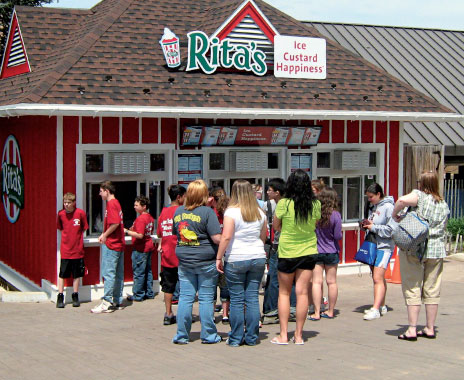For years, Richard Pink mused about expanding his family’s iconic Pink’s Hot Dogs beyond its famed Hollywood location. But he was turned off by the daunting idea of building out the company, hiring more employees, and keeping tabs on franchisees. So he found another way.
In the last few years, Pink’s has opened 10 units through licensing agreements, including several in amusement parks, which have allowed him to expand the brand without substantial investment and without spreading his core staff too thin. Pink says big amusement parks have the personnel and the expertise to run quality foodservice operations that meet his company’s strict standards. And these parks hold a vested interest in getting it right.
“The park is very concerned with the experience of their guest. They want to make sure they don’t have a bad experience,” he says. “So they have to be certain that the product they bring in is a good product.”
The amusement park, with its captive audience, is a prime location for food and beverage sales. Vacationing families arrive expecting to have a good time—and expecting to spend money. In fact, sales are booming at these venues. A 2012 report from Packaged Facts estimated annual food and beverage sales inside amusement parks would reach $2.9 billion amid growing ticket and in-park sales. Even with the competition from internal park restaurants, major quick-service companies are finding amusement park units a low-investment expansion opportunity. The foot traffic inside a park is hard to find anywhere else, allowing brands to both gain exposure and also open up new revenue streams.
Pink says relationships are important, because turning over operations to a major theme park requires a lot more trust than signing a lease agreement or bringing on a new franchisee. His brand is now booming in places like Ohio’s Cedar Point Amusement Park, Universal Studios Hollywood, and Connecticut’s Lake Compounce water park. Pink says these and other nontraditional units are buoying business and will allow the hot dog concept to live on even if something catastrophic were to close the original 75-year-old hot dog stand.
“One of the things we’re always worried about is if Pink’s in Hollywood ceased to exist,” he says. “We now have revenue being generated by these other sources.”
For their part, amusement parks are looking for quality foods that can be prepared and served quickly and concepts that can deliver name recognition, says Albert Cabuco, vice president of food and beverage for Palace Entertainment, which boasts more than 13 million guests annually at its 37 theme parks, water parks, and family entertainment centers. Palace’s parks house franchised restaurants like Subway and also operate licensed units like Pizza Hut Express and Nathan’s. Such branded concepts are usually a small percentage of a park’s offering, Cabuco says, but its staff is well equipped to meet a company’s standards, and big-name brands have proved to perform better than an amusement park’s own proprietary offerings.
“Name recognition drives higher revenues,” he says. “All proprietary concepts that were replaced by branded food units substantially increased the revenues.”
When considering moving into amusement parks and other nontraditional locations, environment is key, experts say.
“Our brand does great where people are having fun,” says Michael Barrette, vice president of marketing and sales for ice cream chain Dippin’ Dots. “There is an expectation in those venues that they’re going to treat themselves.” The brand operates more than 1,200 units in zoos, stadiums, and amusement parks.
Barrette says the parks decide where to locate kiosks or carts, though the brand has input. He says it’s important to be aware of the competitive landscape, but there’s typically plenty to go around in amusement parks. Even when other concepts offer soft-serve or hard-scoop ice cream nearby, Dippin’ Dots keeps busy, he says.
But in a theme park, the biggest threat often isn’t competition—it’s a bad location, says Debbie Rowley, vice president of new market operations for Cinnabon, which has 13 amusement park locations. “We feel the more competition the better,” she says. “What worries me the most in any location I approve is making sure there are bodies there. If there’s a location in a park that’s way over by the bathrooms and nobody goes there, it’s not going to work.”
Quick-service brands must often adapt to fit theme parks’ environment. Sometimes, menu items need to be pared down or specialized, or the design of restaurants must be tweaked to both physically and aesthetically fit. Cinnabon, for instance, has a freestanding location in Universal Studios Hollywood designed to blend in with the area’s English motif.
“We want to fit into the environment,” Rowley says. “While the logo is the same and the product is the same, the actual building is designed to fit into the design of the amusement park.”
Rowley says it’s also important to remember the unique business of amusement parks. Some parks, such as those in the Midwest or East Coast, close for the winter.
“We know that going into it. We’re prepared for it,” she says. “Then when we reopen again, we act like it’s a new store.”










